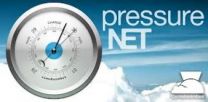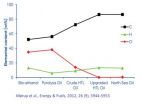(Press-News.org) The next advance in weather forecasting may not come from a new satellite or supercomputer, but from a device in your pocket. University of Washington atmospheric scientists are using pressure sensors included in the newest smartphones to develop better weather forecasting techniques.
"With this approach we could potentially have tens or hundreds of thousands of additional surface pressure observations, which could significantly improve short-term weather forecasts," said Cliff Mass, a UW professor of atmospheric sciences.
Owners of certain new Android smartphones and tablet computers can now download the PressureNet app, which measures atmospheric pressure and provides the data to UW researchers.
When some smartphone manufacturers recently added pressure sensors, to estimate the phone's elevation and help pinpoint its location, Mass saw an opportunity to enhance weather prediction. In the autumn he approached Cumulonimbus, a Canadian app company that developed a barometer application for smartphones that collects all the data and shares it back with users.
The PressureNet app this week collected about 4,000 observations per hour, with users clustered in the northeastern United States and around some major cities.
"We need more density," Mass said. "Right now it's a matter of getting more people to contribute."
Android devices equipped with pressure sensors include Samsung's Galaxy S3, Galaxy Nexus, Galaxy Note and Nexus 4 smartphones, and the Nexus 10 and Motorola Xoom tablet computers.
Atmospheric pressure is the weight of the air above, and includes information about what is happening as air masses collide. Precise tracking of pressure readings and pressure changes could help weather forecasters to pinpoint exactly where and when a major storm will strike.
Mass is particularly interested in the center of the country, which is prone to severe storms but includes fewer weather observation stations.
"Thunderstorms are one of the areas of weakest skill for forecasting," Mass said. "I think thunderstorms in the middle part of the country could potentially be the biggest positive for this approach. They are relatively small-scale, they develop over a few hours, they can be severe and can affect people significantly."
Tracking storms a few hours out could help people better protect themselves and their property. In the Seattle area, the tool could improve short-term forecasts for wind and rain.
"I think this could be one of the next major revolutions in weather forecasting, really enhancing our ability to forecast at zero to four hours," Mass said.
Cumulonimbus updated the app's privacy settings last week so users could allow access to the data by scientific researchers. Since then, the UW group has been uploading the pressure data each hour and preparing it for use in weather forecasting models. The data will soon be available to all researchers who want to incorporate it in weather-prediction tools.
A project begun in 2010 by Mass and Gregory Hakim, a UW professor of atmospheric sciences, has explored ways to improve weather forecasts by taking advantage of surface pressure measurements. The current network of U.S. weather stations offers about one thousand air-pressure readings. Adding observations collected by small-scale weather networks and hobbyists, the UW team found, improves the forecasts. A weather station in every pocket would offer an unprecedented wealth of data.
A recent blog post by Mass explains more about the UW group's approach. Luke Madaus, a UW graduate student in atmospheric sciences, will load the smartphone data into a weather-forecasting system. At first the tool will use only stationary data points, but eventually it may include data from devices in motion.
Building the system will take a few months, Mass said. By this summer's thunderstorm season he hopes the UW team will be using smartphone data to forecast storms and compare their results against traditional forecasts.
If the technique is successful, the researchers hope to supply it to the National Weather Service and the weather bureaus of other countries.
The technique could be particularly useful, Mass noted, in countries that have little weather-forecasting infrastructure but where smartphones are becoming more common.
INFORMATION:
The research has been funded by Microsoft Corp. and the National Weather Service.
For more information, contact Mass at 206-685-0910 or cliff@atmos.washington.edu.
Smartphones, tablets help scientists improve storm forecasts
2013-02-07
ELSE PRESS RELEASES FROM THIS DATE:
Happiness increases with age, across generations
2013-02-07
Psychological well-being has been linked to many important life outcomes, including career success, relationship satisfaction, and even health. But it's not clear how feelings of well-being change as we age, as different studies have provided evidence for various trends over time.
A new report published in Psychological Science, a journal of the Association for Psychological Science, reveals that self-reported feelings of well-being tend to increase with age, but that a person's overall level of well-being depends on when he or she was born.
Psychological scientist ...
Tiny capsule effectively kills cancer cells
2013-02-07
A tiny capsule invented at a UCLA lab could go a long way toward improving cancer treatment.
Devising a method for more precise and less invasive treatment of cancer tumors, a team led by researchers from the UCLA Henry Samueli School of Engineering and Applied Science has developed a degradable nanoscale shell to carry proteins to cancer cells and stunt the growth of tumors without damaging healthy cells.
In a new study, published online Feb. 1 in the peer-reviewed journal Nano Today, a group led by Yi Tang, a professor of chemical and biomolecular engineering and ...
Personalized health care will revolutionize 21st century medicine, says NJIT professor
2013-02-07
A closer look at personalized or point-of-care healthcare was the focus of a recent international conference in India organized and chaired by NJIT Distinguished Professor Atam Dhawan. The IEEE Engineering in Medicine and Biology Society (EMBS) International Special Topic Conference in point-of-care healthcare technologies, broadcast around the world, focused on topics ranging from 21st century medicine with new smart cross-and trans-disciplinary technologies to how wireless communications will change how physicians care for patients.
"The last century witnessed a ...
Stanford researcher sheds new light on the mysteries of spider silk
2013-02-07
As fibers go, there's never been anything quite like spider silk. Stretch it. Bend it. Soak it. Dry it out. Spider silk holds up. It is five times stronger than steel and can expand nearly a third greater than its original length and snap right back like new. Ounce-for-ounce spider silk is even stronger than Kevlar, the man-made fiber used in bulletproof vests.
It would be understandable to think that science knows all there is to know about the remarkable physics of spider silk, but the truth is far from that. Now, using a long-known-but-underutilized spectroscopy technique, ...
Hydrothermal liquefaction -- the most promising path to a sustainable bio-oil production
2013-02-07
To emphasize, the HTL process accepts all biomasses from modern society – sewage sludge, manure, wood, compost and plant material along with waste from households, meat factories, dairy production and similar industries.
It is by far the most feedstock flexible of any liquid fuel producing process, including pyrolysis, bio-ethanol, gasification with Fischer-Tropsch or catalytic upgrading of different vegetable or agro-industrial residual oils, and does not carry higher costs than these.
Hydrothermal liquefaction is basically pressure cooking, but instead of cooking the ...
India joined with Asia 10 million years later than previously thought
2013-02-07
CAMBRIDGE, Mass. -- The peaks of the Himalayas are a modern remnant of massive tectonic forces that fused India with Asia tens of millions of years ago. Previous estimates have suggested this collision occurred about 50 million years ago, as India, moving northward at a rapid pace, crushed up against Eurasia. The crumple zone between the two plates gave rise to the Himalayas, which today bear geologic traces of both India and Asia. Geologists have sought to characterize the rocks of the Himalayas in order to retrace one of the planet's most dramatic tectonic collisions.
Now ...
Preserving biodiversity can be compatible with intensive agriculture
2013-02-07
UNIVERSITY PARK, Pa. -- Preserving genetically diverse local crops in areas where small-scale farms are rapidly modernizing is possible, according to a Penn State geographer, who is part of an international research project investigating the biodiversity of maize, or corn, in hotspots of Bolivia, Peru and Mexico.
Hotspots are areas where cultivation of peaches and other non-traditional crops has exploded over the past decade, noted Karl Zimmerer, professor and head of the Department of Geography, and where small-scale farms are often female-run and have been previously ...
Compound stimulates tumor-fighting protein in cancer therapy
2013-02-07
HERSHEY, Pa. --A compound that stimulates the production of a tumor-fighting protein may improve the usefulness of the protein in cancer therapy, according to a team of researchers.
TRAIL is a natural anti-tumor protein that suppresses tumor development during immune surveillance -- the immune system's process of patrolling the body for cancer cells. This process is lost during cancer progression, which leads to uncontrolled growth and spread of tumors.
The ability of TRAIL to initiate cell death selectively in cancer cells has led to ongoing clinical trials with artificially ...
People seek high-calorie foods in tough times says University of Miami study
2013-02-07
Bad news about the economy could cause you to pack on the pounds. This according to a new study from the University of Miami School of Business Administration published in the February edition of Psychological Science, a journal of the Association of Psychological Science. The study shows that when there is a perception of tough times, people tend to seek higher-calorie foods that will keep them satisfied longer. When subconsciously primed with such messages, a "live for today" impulse is triggered causing people to consume nearly 40 percent more food than when compared ...
Understanding microbes blowing in the wind
2013-02-07
With help from a wind tunnel and the latest DNA technology, U.S. Department of Agriculture (USDA) scientists are shedding light on the travel patterns of microbes in soils carried off by strong winds. The work has implications for soil health and could lead to management practices that minimize the damage to soils caused by wind erosion.
Wind erosion is an emerging issue in soil conservation efforts. Agricultural Research Service (ARS) scientists have been studying wind-eroded soils since the 1930s, but few studies have focused on the effects of wind on the bacteria, ...


